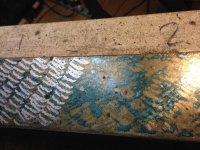And that was supposed to be prussian blue, not pursian blue...
LOL! Could use "Persian Orange". The classical Allis-Chalmers tractor paint.
More seriously... if neither plate shows discoloration, such a 'graying' on the black one, or worn areas obvious to a standard-issue Mark One human Eyeball, they are probably flatter than you - or MOST of us, really - have the skills or equipment - and above all borderline insane levels of patience and dedication - to make them.
My tiny 9" X 12" 1959 vintage 50-millionths flat Do All sez that is one-half the wavelength of visible AKA 'white' light. It is only used to vet other metrology goods, kept covered and protected for sometime several years between uses.
Workaday used B&S "B" grade 18" x 24" has obvious wear. If prepping a transfer straight edge, I simply avoid those areas.
The Herman 30" X 48" left the factory a very long time ago as a 4-ledge grade A. I'm happy the last calibration stickers show it was still such when the company as owned it went tits-up and it went off to a used equipment dealer, thence to me. Still and all, "perfect all over" it no longer is.
BFD. Once again - just avoid the dodgy coloration spots, and use the better areas.
When it even matters.
Which - for most of us, is damned seldom for the work we actually DO, not dream about.
Now.. if you actually have a NEED, then get a pro to make a service call with his Planikator, magical pixie dust collection, and half a lifetime of doing SP touch-up
and issuing certs, all day, every day.
BTW: Any surface plate has to have set and stabilized for 'a while' before you even consider that. Closer to 24 days than 24 hours, that is.
No certs to be had, or no NEED of certs in your environment == no justification for the spend.
DIY?
Well.. have you done this before? Under expert on-site supervision? Flown off and taken a course in it?
Based only on 'interest', wish-for, and internet advice, even a fair-decent craftsman who has-never can f**k-up an average decent plate faster and more easily than improve it.
You just bought a decent Starrett? JF use it.






 . Im a believer, thats a very interesting method of reading the bubble
. Im a believer, thats a very interesting method of reading the bubble  . Could think of situations where it could come in very handy.
. Could think of situations where it could come in very handy.